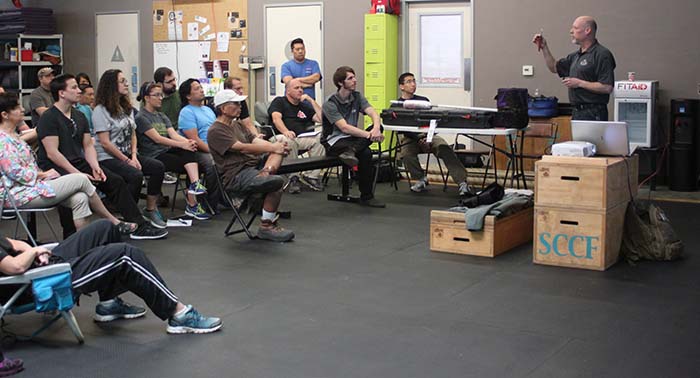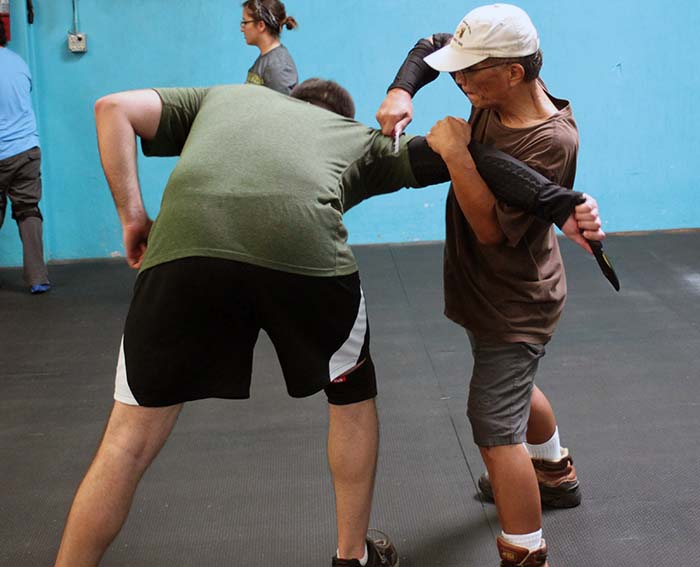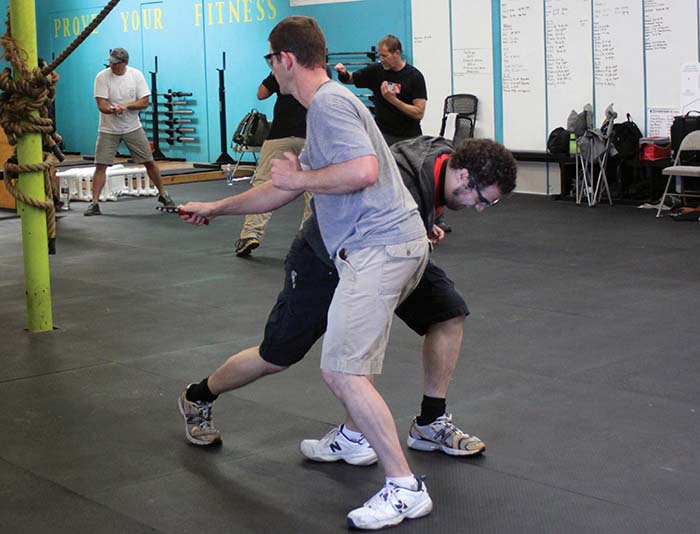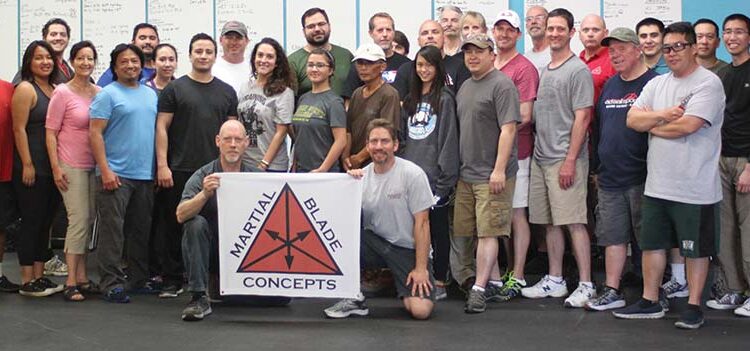By Patty Sweat
“Martial Blade Concepts (MBC) is an edged-weapon system specifically designed to meet the needs of today’s concerned citizen and armed professional. Based on Michael Janich’s extensive analysis of the Filipino martial arts and many other systems, MBC takes combat-proven tactics and adapts them to modern tools, threats, and legal concerns. The result is a practical, easy-to-learn system that is ideally suited to modern self-defense.” (www.martialbladeconcepts.com/)
SAR was given the unique opportunity to not only attend a course, but to interview Michael Janich. He broke down the logic of MBC and emphasized the main difference between it and traditional martial arts knife systems – its focus on self-defense.
He explained that the roots of MBC can be found in the Filipino martial arts – a culture that was forced to establish defensive techniques due to several periods of occupation by invaders from Spain and Japan. The arts of Kali, Eskrima, and Arnis he explained, “are based on some of the most extensive research and practical application of edged weapons in history.” Unlike other cultures that used swords – such as Europe and Japan – the Filipino arts focused heavily on utilizing easily concealable knives. This technique was the best foundation for the use of today’s modern defensive knives, such as tactical folders.

Understanding the Logic
“MBC’s logic not only forms the core of the ‘why’ of what we do; it also forms the foundation of the system’s strength as a moral, ethical, and legally defensible approach to using a knife for personal defense.”
Understand the destructive power of your actual carry knife
First, understand that you’ll fight with the knife you carry. Knife laws vary from state to state, but for most, a legal, practical carry knife will be a lock-blade folder with a blade 3-4 inches in length. Historical tactics using a KA-BAR or a tanto with a 6-inch blade thrust into a torso could easily penetrate deep enough to inflict stopping power, however, the same thrust with a 3-inch blade – especially against an adrenalized attacker – may not have the same stopping effect.
Understand that “Stopping Power” is the goal of all self-defense
Like firearm tactics, stopping power is the main goal. However, a knife causes damage differently and not nearly as immediate as a bullet. Unlike battle, in self-defense we don’t shoot to kill; we shoot to stop. Conceptually, the defensive application of the knife is the same. The goal is to stop the attacker from delivering violence to you.
This is where the tactic of “defanging the snake” (common in the Filipino martial arts) against contact-distance weapons emerges. By cutting the flexor tendons of the attacker’s weapon-wielding arm, you disable it and ideally disarm him — instantly. “We don’t have to stop the life-supporting functions to stop the attack; we just have to stop the mechanical function of the limbs that enable the attack.”

Have an understanding of human anatomy
“Once you understand the type of damage you can do with your carry knife and relate that to an attacker’s body, the next step is to figure out which parts of your attacker’s body you can realistically target to achieve reliable, predictable stopping power.”
If “defanging the snake” (as referenced earlier) isn’t successful, the next target is the bicep and triceps muscles of the upper arm – if the attacker can’t articulate his elbow, he can’t swing again.
The ultimate stopping target is the quadriceps muscle, just above the knee. About the same size as a sirloin steak — ¾-inch thick and approximately 4-inches wide – it is easily cut to the bone with a 3-inch blade. Severing this muscle destroys function instantly and the attacker will collapse to one knee – allowing you to create distance and escape.
When most people think of knife fights, they tend to imagine scenes from Hollywood – glorified martial art fights that have not only been choreographed, but with unrealistic end results. They also tend to think of military-style knife fighting – especially the tactics from WWII combat manuals. Unfortunately, many of the common misconceptions about knife tactics appeared during this period; a time in U.S. history where young men from various backgrounds (i.e. accountants, translators, teachers) were thrown into a war and told, “You will need to kill.” To build confidence in these neophyte soldiers, instructors often exaggerated the effects of the tactics they taught.
Michael explained that many of the misconceptions about blood loss in knife fighting can be traced back to the classic “Timetable of Death” published by British close-combat legend, W.E. Fairbairn. Michael, along with the late Christopher Grosz, a former law enforcement officer and defensive tactics instructor from Littleton, Colorado, challenged the veracity of this timetable, worked with medical examiners, and concluded that it was, in fact, inaccurate. Through joint research with the assistance of recognized experts in both the medical and tactical fields, a modern and medically accurate version of Fairbairn’s timetable was constructed. Unfortunately, Christopher passed away and Michael wrapped up the research in a published book, “Contemporary Knife Targeting: Modern Science vs. W.E. Fairbairn’s Timetable of Death”. (All royalties go towards Christopher Grosz’s family)

Establish training techniques with clear purpose and structure, utilizing a system of movements consistent with instinctive reactions to stress
Most martial arts consist of several thousand techniques which take a lifetime to learn, let alone learn well enough to use reflexively. In a life-threatening fight, your body will naturally react with power survival instincts. “Unless you are incredibly trained, instinct will take precedence and you will do ‘it’ before you do anything else.” That is why MBC uses instinct and instinctive reactions like the “startle response” as the foundation of their skills.
Additionally, the best way to do something well is that of repetition. Once you can perform a drill fluidly, you and your partner increase the speed, intensity, and energy of the drill. This challenges your reflexes progressively and accurately replicates the type of stress you’d experience in a real encounter.
Emphasize practical knife deployment tactics
As Michael candidly explained: the first rule of fighting with a knife is to have a knife. Many knife-training systems focus exclusively on training with knife-in-hand or base their deployment tactics on classical means of carry.
“If you are attacked at close range, your first reaction should not be to draw your knife but to minimize injury to you through any means possible. Typically this means defending yourself with empty-hand combative skills to buy the time and the opportunity to draw your blade.” Also, because producing your knife in stressful conditions can prove to be extremely difficult, MBC emphasizes deployment methods utilizing gross motor skills to eliminate complex movements. It also helps to “practice your draw regularly until it literally becomes second nature”.

MBC – Edged-Weapon Training for Today’s World
In addition to providing a system of easily learned, highly effective tactics that work with legal-to-carry knives, MBC also emphasizes the legal aspects of personal defense. Its tactics are medically sound and emphasize stopping, not killing, and are therefore more morally and legally defensible that traditional knife systems.
Personal Note from Author:
“Like many of the other students in the class, I realized that although I’ve carried a knife religiously during most of my adult life, I really had no clue how to fight ‘effectively’ with it. This course changed all that. It not only taught us usable skills to defend ourselves in close quarters, but also addressed the legal and moral aspects of using a knife as a weapon. Michael Janich truly has a gift for teaching and his passion for the logic and skills of MBC is contagious. I am extremely grateful to Michael for introducing me to MBC and to the seminar host, MBC Affiliate Instructor Uli Gebhard, for allowing me to attend. I can’t wait to do more training!”
MBC has a network of instructors and study group leaders nationwide and in several foreign countries. Michael Janich and his certified instructors also teach MBC seminars all over the world. The “Instructor Locator” on the www.martialbladeconcepts.com web site can help you find an instructor near you. If there isn’t one, MBC also has an on-line Distance Learning Program and a complete library of training DVDs on MBC and Janich’s related self-defense systems.
| This article first appeared in Small Arms Review V20N5 (June 2016) |











